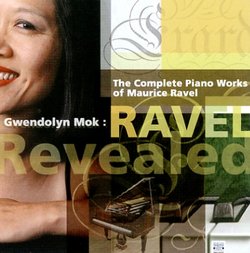| All Artists: Gwendolyn Mok Title: Ravel Revealed: Complete Piano Works of Ravel (Gwendolyn Mok) Members Wishing: 0 Total Copies: 0 Label: MSR Classics Original Release Date: 1/1/2002 Re-Release Date: 6/25/2002 Genre: Classical Styles: Chamber Music, Historical Periods, Classical (c.1770-1830) Number of Discs: 2 SwapaCD Credits: 2 UPC: 681585107027 |
Search - Gwendolyn Mok :: Ravel Revealed: Complete Piano Works of Ravel (Gwendolyn Mok)
 | Gwendolyn Mok Ravel Revealed: Complete Piano Works of Ravel (Gwendolyn Mok) Genre: Classical |
Larger Image |
CD Details |
CD ReviewsRavel, Erard, and Mok a shopper | 03/28/2003 (5 out of 5 stars) "Recordings of Ravel's piano music (all of it) are not rare, a testimony to the appeal this splendid music has held for pianists and listeners alike for over a century. Many of the finest pianists of the last century have bestowed upon us outstanding performances of these treasures; Casadesus, Entremont, and Gieseking, are among the artists whose interpretations have enriched our libraries. Therefore, you may reasonably ask, 'Do I need another Ravel recording?' or, if you are seeking an introduction to this music, 'Why Gwendolyn Mok?' To persuade you that her recordings are worthy of your attention, whether this music be old and beloved or new and seductive, is the reason I am writing this report.
So what has Mok wrought? If you first heard the keyboard music of Bach and Scarlatti played upon the piano, do you remember the revelation when you first heard Landowska on a Playel, or Valenti on a Challis? Well, that is what Mok has in store for us, Ravel's music on Ravel's piano, or one very close to it, to be precise and specific, an Erard of about the same vintage as Ravel himself, 1875. There are a number of differences between a nineteenth century Erard, and the twentieth century grands that are ringing in our ears. I'll not labor over the mechanical developments that overtook piano construction in the twentieth century, suffice it to say, pianos grew bigger and louder and more brilliant so they could fill larger concert halls and do battle with larger orchestras. I find an interesting symmetry here that works to this recording's advantage. Mok takes us back more than a century in piano technology to an instrument with a narrower dynamic range and a more delicate, pliable tone, while recording technology has advanced in it's ability to capture subtler nuances with virtually no distortion. She brings us close to, and deeper into, the music, without any apparent loss of power when that is called for. That the instrument is comparatively diminished does not diminish the music, it renders it subtler. For example, the harpsichord like sounds of the Menuet Antique can hardly be coaxed from a modern grand. The clear and resonant bass is a wonder on this instrument and the pianist can muster her resources to produce thrilling crescendos and climaxes. This is not skimpy music! The composer, the instrument builder, and the pianist, serve each other well here, and the listener harvests the riches.P.S. If you wish to know more about Mok and her Erard, visit her website. To get there, type in her full name, and the ever popular final cadence, .com." |
